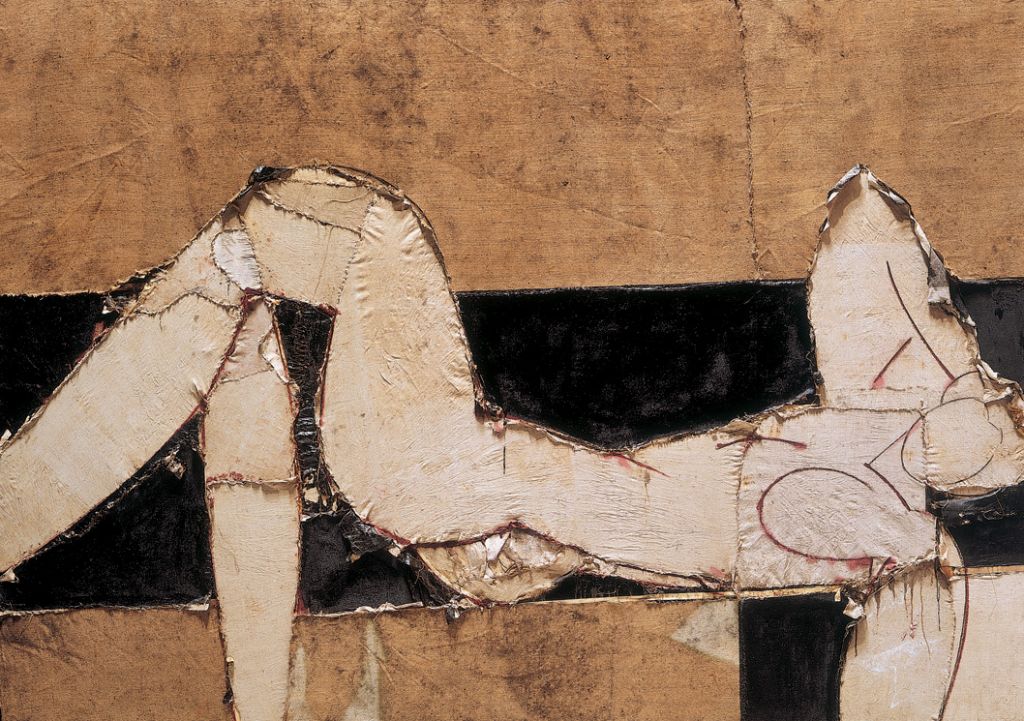Manolo Valdés. Painting and Sculpture
10.18.2002 - 01.19.2003
An exhibition devoted to the solo career of Manolo Valdés (Valencia, 1942), an internationally renowned Spanish artist who has played a major role in the art of the last thirty years of the twentieth century. Striking out on his own in 1981, Valdés recreated and recontextualized some of Western art's most representative icons, continuing the work done by the art team known as Equipo Crónica, which he was a member of for nearly 20 years. Valdés creates his own private language through the production of series used to play variations on a central theme. He also enriches and extends his interests through the use of unusual materials in his search for texture.
Manolo Valdés began his career as a founding member of Equipo Crónica, a leading movement in Spanish Pop art during the Franco regime. Much of his early work recycles recognizable elements from the history of art. The work on view at the Guggenheim Museum Bilbao was created in New York where the artist has lived and worked since 1990. About New York he says, "This is where I've found my space. This is where I survive. The day I leave, someone else pretty much like me will come along and take my place. This town won't lose anyone."
Valdés embarked on his characteristic revisions in 1982, initially placing emphasis on the support, on the use of collage and paper with a constructive and immaterial sense. When Art Informel, Abstract Expressionist, and formalist criticism were predominating trends, the artist devoted himself to a personal figuration. His brand of realism promised to make legible what Abstract Expressionism eschewed.
Although Valdés has had exhibitions the world over, few of these have been retrospectives of his solo career. Equipo Crónica, however, has been the subject of presentations at a host of institutions, including the Bilbao Fine Arts Museum, Museo Nacional Centro de Arte Reina Sofía, Madrid, and at the 7th International Contemporary Art Fair, Guadalajara, Mexico.
Over a 20-year career, Valdés has received accolades including Valencia's Alfons Roig Prize and National Fine Arts Award, Spain. In 1985, he was presented with Spain's National Medal for Painting and in the following year the biennial medal at the Baghdad International Festival of Arts in Iraq. In 1993, Valdés was awarded the Order Andrés Bello Medal, first class, band of honor from Venezuela (a distinction awarded to Spanish sculptor Eduardo Chillida the year previous) and in 1999, along with Esther Ferrer, he was chosen to represent Spain at the 48th Venice Biennale.
Manolo Valdés takes a close look at the artist's sculpture (a relatively unknown facet of his work until now) in relation to his painting. For the first time, his painting and sculpture are presented as correlate parts that share and reflect visual, iconic, and material resolutions. Rather than underscore the interest of his sculpture, this exhibition suggests that painting and sculpture have gone hand in hand in the artist's practice since the beginning of his career.
Valdés's public sculpture dates from 1999 when he began work on a project for Bilbao. In the same year, he received a commission for a major project for Valencia in connection with the famous Dama de Elche (Lady of Elche) sculpture, for which the first large-scale model was installed on Park Avenue, New York. In 2000, his 11-ton, seven-meter-high sculpture titled Menina was installed in the roundabout of Salvador Allende boulevard in the Paseo de la Chopera, Alcobendas, Madrid.
This exhibition presents a selection of oil paintings, mixed-media works and sculptures executed by Manolo Valdés over the last almost 20 years and provides insight to the philosophies of this great artist, who in addition to being a major figure on the Spanish art scene is a clear and profound voice in contemporary discourse on the history of art in the field of international aesthetics.
Avoiding chronological organization, the exhibition presents the artist's work by theme, issue, and sensibility. Valdés's wood sculpture on seated women, still lifes, and tables, as well as the reference to Picasso's Bathers and to Léger, contrast with the titanium, steel, and glass of Frank Gehry's remarkable building. To warm the corridor linking gallery 303 with the classical galleries, the artist created his largest-ever library to date, a wall of books five meters high. In his essay The Library of Wood (La biblioteca de madera), writer Antonio Muñoz Molina says, "While some of us write books, collect them, or just accumulate them, Manolo Valdés carves, organizes, and sets them against a wall. He's a sort of a false bibliophile, a book-mad carpenter or wood-cutter who, as he carves these impossible volumes, is really celebrating the simple, magic form of the book."
In much of his work, Valdés comes close to being an art historian. An avid collector of data, his knowledge of art history is vast. His work acts primordially to reconfigure "histories already painted." But Valdés does not simply appropriate, instead he presents fragments that, like the pieces of the Pyrenees river raft, must be assembled before their function is revealed. Again like a raft, the artist's oeuvre is built from fragments that, when brought together, con-form a new body in which to float down the not-always-calm waters of art history. It is a memory for detail that presents great images from the past.
Kosme de Barañano
Exhibition Curator
Manolo Valdés
Matisse as Pretext (Matisse como pretexto), 1987
Mixed media on burlap
170 x 240 cm
Guillermo Caballero de Luján Collection, Valencia

